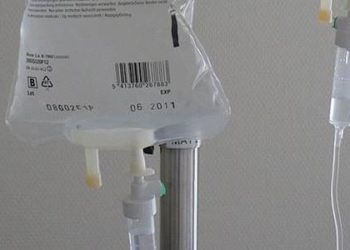2 Minute Medicine Rewind July 9, 2018
Platelet Counts during Pregnancy
Gestational thrombocytopenia has traditionally been defined as a platelet count of less than 150,000 per cubic millimeter during pregnancy in the absence of a known cause. Gestational thrombocytopenia has been associated with pregnancy-related complications. Even in uncomplicated pregnancies, it is thought that platelet counts begin to decrease in the mid-second to third trimester and continue to decrease until delivery. However, the occurrence and severity of thrombocytopenia in pregnancy have not been well-studied. In this retrospective study, researchers evaluated platelet counts in 7,351 women with and without pregnancy-related complications and in 8,885 healthy non-pregnant women to determine the course of platelet counts throughout pregnancy, delivery, and the postpartum period. Researchers found that in women with uncomplicated pregnancies, the mean platelet count in the first trimester was significantly less than that of non-pregnant healthy women (251,000 per cubic millimeter vs. 273,000, p<0.001). Platelet counts below 150,000 per cubic millimeter at the time of delivery were more common in women with pregnancy-related complications than in those without complications (11.9% vs. 9.9%, p=0.01). A greater proportion of women with pregnancy-related complications than without complications had a platelet count below 100,000 per cubic millimeter (2.3% vs. 1.0%) and below 80,000 per cubic millimeter (1.2% vs. 0.1%). In all study subpopulations, mean platelet counts decreased significantly throughout pregnancy (p<0.001). This study therefore indicates that platelets counts in all women decrease throughout pregnancy, and emphasizes that in pregnant women with a platelet count below 100,000 per cubic millimeter without a known pregnancy-related complication, a non-pregnancy cause must be considered.
Liquid-based cytology (LBC) screening combined with HPV testing has significantly reduced cervical cancer morbidity and mortality in the United States. However, the role of primary HPV testing alone remains unclear, and concerns exist regarding the higher theoretical false positive. In this randomized controlled trial, 19,009 women age 25 to 65 years with no history of cervical intraepithelial neoplasia grade 2 or worse (CIN2+) in the past 5 years were assigned to either HPV testing alone l or LBC to determine the rates of CIN3+ at 48 months. The intervention group received primary HPV testing followed by recall at 48 months in women with a negative test result, or reflex LBC in those with positive test results. The control group received primary LBC testing followed by recall at 24 months in those with a negative test result, or reflex HPV testing in those with atypical squamous cells of undetermined significance (ASCUS). Researchers found that there were significantly more CIN3+ cases detected in the intervention group than in the control group in the first round of screening (RR 1.61, 95% CI 1.09 to 2.37). By 48 months, significantly fewer CIN3+ and CIN2+ cases were detected in the intervention group as compared with the control group (CIN3+ RR 0.42, 95% CI 0.25 to 0.69, CIN2+ RR 0.47, 95% CI 0.34 to 0.67). Cumulatively, there were no significant differences in the incidence of disease detection between the two groups. Interestingly, cumulative colposcopy rates were similar between the two groups (absolute difference 4.7, 95% CI -4.0 to 13.4). This study was limited by the fact that women in both groups had received both HPV and cytology co-testing by 48 months. Overall, this study suggests that primary HPV testing detects CIN2+ earlier and more accurately than cytology. Further analyses are required to assess the cost-effectiveness of primary HPV screening as compared to standard-of-care LBC screening.
Cabozantinib in Patients with Advanced and Progressing Hepatocellular Carcinoma
The rate of hepatocellular carcinoma (HCC) mortality in the United States is rapidly rising, and additional treatment options are needed for patients with advanced disease. Tyrosine kinases such as VEGF, MET, and AXL are induced by tumor hypoxia and contribute to tumor invasion and metastasis. Cabozantinib, an inhibitor of VEGF 1, 2, and 3, MET, and AXL, has been shown to impede tumor growth in mice with HCC, and has shown clinical activity in a phase 2 trial in humans. In this phase 3, randomized controlled trial, 773 patients with advanced HCC previously treated with sorafenib (a tyrosine kinase inhibitor) were randomized 2:1 to receive cabozantinib or placebo to study overall and progression-free survival. Researchers found that the median overall survival was significantly greater in the cabozantinib group as compared with the placebo group (10.2 months vs. 8.0 months, HR 0.76, 95% CI 0.63 to 0.92, p=0.005). Median progression-free survival was also significantly longer in the cabozantinib group as compared with placebo (5.2 months vs. 1.9 months, HR 0.44, 95% CI 0.36 to 0.52, p<0.001). The objective response rate was higher in the cabozantinib group than in the placebo group (4% vs. <1%, p=0.009). Grade 3 or 4 adverse events occurred more frequently in the cabozantinib group than in the placebo group (68% vs. 36%), with the most common high-grade events including palmar-plantar erythrodysesthesia (17% with cabozantinib vs. 0% with placebo) and hypertension (16% vs. 2%). Serious adverse events were also more frequent in the cabozantinib group (50% vs. 37%). In summary, this study suggests that cabozantinib may induce longer overall and progression-free survival in patients with advanced hepatocellular carcinoma previously treated with sorafenib, although the risk of treatment-related adverse events must be considered when employing this pharmacotherapy.
Patisiran, an RNAi Therapeutic, for Hereditary Transthyretin Amyloidosis
Hereditary transthyretin amyloidosis is an autosomal dominant fatal disease caused by TTR gene mutations, in which mutant and wild-type transthyretin protein secreted by the liver form amyloid deposits in vital organs, causing cardiomyopathy and polyneuropathy. Survival ranges from 2 to 15 years after the onset of neuropathy, and only 2 to 5 years after the onset of cardiomyopathy. Currently, treatment options include liver transplantation and transthyretin tetramer stabilizers, however both options are suboptimal in preventing disease progression. Patisiran is a hepatically-directed RNA interference (RNAi) therapy that causes the cleavage of transthyretin messenger RNA (mRNA), and has shown clinical activity in a phase 2 study in patients with hereditary transthyretin amyloidosis. In this phase 3, randomized controlled trial, 225 patients were assigned 2:1 to receive patisiran or placebo to study the impact on the modified Neuropathy Impairment Score+7 (mNIS+7), a composite of motor, sensory, and autonomic neuropathy. Researchers found that, in the patisiran group, serum transthyretin levels were rapidly reduced by a median of 81% and were sustained at this level over the 18-month trial period. The change from baseline mNIS+7 was significantly lower in the patisiran group than in the placebo group (least-squares mean change in mNIS+7 from baseline -6.0 ± 1.7 vs. 28.0 ± 2.6, respectively, least-squares mean difference, -34.0 points, 95% CI -39.9 to -28.1, p<0.001). At 18 months, significantly more patients in the patisiran group experienced an improvement in the mNIS+7 (56%, 95% CI 48% to 64%) as compared with the placebo group (4%, 95% CI 0 to 8, p<0.001). The change from baseline in the Norfolk QOL-DN score was also significantly lower with patisiran than with placebo at 18 months, indicating improved quality of life with patisiran (least-squares mean difference, -21.1 points, 95% CI -27.2 to -15.0, p<0.001). The frequency of severe and serious adverse events was similar in the patisiran group (28%, 36% respectively) and the placebo group (36%, 40%, respectively). Common adverse events occurring more frequently with patisiran than with placebo included peripheral edema (30% vs. 22%) and infusion-related reactions (19% vs. 9%). In summary, this trial indicates that patisiran may provide significant clinical benefit to patients with hereditary transthyretin amyloidosis.
Insulin analogs for the treatment of type 2 diabetes have become increasingly popular in clinical practice during the last decade, despite being more costly than human insulin. Clinical trials have shown that long-acting insulin analogs modestly reduce the risk of nocturnal hypoglycemia compared with human insulin. However, health outcomes associated with long-acting insulin analogs have not yet been studied in clinical practice. In this retrospective observational study, 25,489 patients with type 2 diabetes who initiated either basal human neutral protamine Hagedorn (NPH) insulin or the insulin analog glargine or detemir between January 1, 2006 and December 31, 2014 were analyzed to study the impact of insulin initiation on time to a hypoglycemia-related ED visit or hospital admission. The secondary outcome was change in hemoglobin A1C. Researchers found that there was no significant difference in the incidence of ED visits and hospital admissions related to hypoglycemia between patients who started NPH insulin (8.8 events per 1000 person-years, 95% CI 7.9 to 9.8) and those who started insulin analogs (11.9 events per 1000 person-years, 95% CI 8.1 to 15.6) (between-group difference 3.1 events per 1000 person-years, 95% CI -1.5 to 7.7, p=0.07). The reduction in hemoglobin A1C level was significantly greater within one year of initiation of NPH insulin than with insulin analogs (difference-in-differences -0.22%, 95% CI -0.09% to -0.37%). However, this difference was not considered clinically significant. Overall, this study suggests that there are no clinical advantages associated with the use of a basal insulin analog over NPH insulin.
Image: PD
©2018 2 Minute Medicine, Inc. All rights reserved. No works may be reproduced without expressed written consent from 2 Minute Medicine, Inc. Inquire about licensing here. No article should be construed as medical advice and is not intended as such by the authors or by 2 Minute Medicine, Inc.









